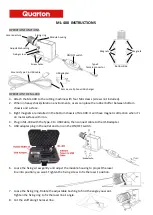
39
mode should be avoided. The measured distances may be wrong or inaccurate
When the [MEASURE] key is triggered, the EDM measures the object which is in the beam path at that moment.
If e.g. people, cars, animals, swaying branches, etc. cross the laser beam while a measurement is being taken, a
fraction of the laser beam is reflected and may lead to incorrect distance values.
Avoid interrupting the measuring beam while taking reflectorless measurements or measurements using
reflective foils.
Reflectorless EDM
●Ensure that the laser beams cannot be reflected by any object nearby with high reflectivity.
●When a distance measurement is triggered, the EDM measures to the object which is in the beam path at that
moment. In case of temporary obstruction (e.g. a passing vehicle, heavy rain, snow, frog, etc.), the EDM may
measure to the obstruction.
●When measuring longer distance, any divergence of the red laser beam from the line of sight might lead to less
accurate measurements. This is because the laser beam might not be reflected from the point at which the
crosshairs are pointing. Therefore, it is recommended to verify that the R-laser is well collimated with the telescope
line of sight. (Please refer to “24.11 REFLECTORLESS EDM”)
●Do not collimate the same target with 2 total stations simultaneously.
Red Laser Distance Measurement Cooperated with Reflective Foils.
The visible red laser beam can also be used to measure to reflective foils. To guarantee the accuracy the red laser
beam must be perpendicular to the reflector foil and it must be well adjusted (refer to “24.11 REFLECTORLESS
EDM”).
Make sure the additive constant belongs to the selected target (reflector) has been input on total station.
9.1 Settings for Distance Measurement
·
Perform the following settings before distance measurement.
·
Atmospheric correction factor.
·
Prism constant correction value.
·
Distance measurement mode.
EXPLANATION Atmospheric correction
·
After setting atmospheric correction, the distance measurement result will be corrected automatically, because the
velocity of the light in air is affected by the temperature and air pressure.
Calculate the atmospheric correction factor as shown in following formula.
Summary of Contents for KTS440 L Series
Page 9: ...9 3 NOMENCLATURE ...
Page 10: ...10 ...
















































